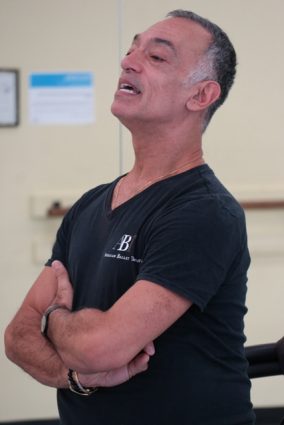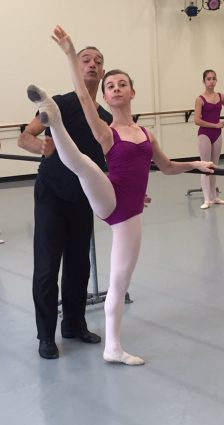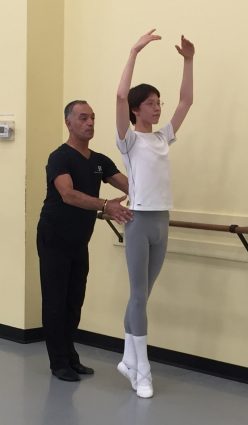Sacred. That’s how Olivier Munoz described the ballet studio with its well-worn floor, mirror-lined walls, barres hugging the perimeter and scent of sweat and hairspray. “I know what happens here,” he said looking around an empty sunlit Maryland Youth Ballet (MYB) studio shortly before it fills with leotard-clad youngsters anxious to stretch, bend, point and flex in an effort to mold their young bodies into the elegant lines and curves that classical ballet demands.
“I know the beauty and the effort and the work that goes into that creative process,” he continued. “I think classwork is beautiful. The sweat is beautiful. When you start working on a ballet, it’s not one person; it [needs] everyone to make the ballet. It’s that sense that you’re creating something together, some magic, some story … That’s the beauty of dance.”

The French-trained ballet dancer began his own studies at the National Conservatory of Dance in Lyon where he discovered the beauty and demands of the French-born art form. At just 18, Munoz received one of the ballet world’s top honors: the 1981 Prix de Lausanne. Now 56, he is bringing his decades of experience, including 14 years as principal teacher at Orlando Ballet School following an illustrious career at the English National Ballet and Cleveland San Jose Ballet, to take the helm of Maryland Youth Ballet.
The venerable Montgomery County institution had its beginnings in Costa Rican native Hortensia Fonseca’s Kensington basement, where she taught ballet to neighborhood children, choosing motherhood rather than a performing career. She founded MYB in 1971 and the illustrious list of alumni reads like a Who’s Who of late 20th-century American dance. Among her most successful proteges: former American Ballet Theatre principals Susan Jaffe, Cheryl Yeager and Julie Kent, who is now artistic director of The Washington Ballet. Alums dance in the world’s most prestigious companies including New York City Ballet, Alvin Ailey American Dance Theater, San Francisco Ballet, Mark Morris Dance Group, Royal Danish Ballet, Nederlands Dans Theater, Batsheva Dance Company and An American in Paris on Broadway.

Presently located on Ellsworth Drive in the heart of Downtown Silver Spring after a move from Bethesda in 2007, the school is thriving. Munoz will be its third artistic leader when current director Michelle Lees steps down after more than 40 years of teaching, choreographing, coaching and encouraging thousands of students from their first plies to first Nutcrackers and pointe shoe fittings. Some become professionals. Others are doctors, lawyers, teachers, architects, bankers and more. The school has grown to nearly 1,600 students and afterschool and Saturday classes are packed. Of the 950 children, including 400 2- to 4-year-olds in the Early Dance Division and 300 in the Introductory Division, 250 aspiring dancers, ages 8 to 19, study three to six days a week in the Academy Division, focusing on classical ballet with electives in modern, contemporary, African and jazz dance supplementing pointe, partnering and boys and men’s classes.
On a recent Friday afternoon, Munoz, clad in crisp white pants, a T-shirt and ballet slippers, demonstrated a foot warmup at the barre as 20 dancers observe closely before repeating it. He walked through the ranks, while the pianist played, coaxing a leg a little higher, shaping a wilting elbow or a wayward knee.
While Munoz acclimates to his new role at MYB, he is no stranger to the studio or the region. From 2000 to 2006, shortly after he left the stage, he was a senior faculty member at the school, teaching academy, boys and men’s, and adult classes. So, it’s a homecoming of sorts. And after shadowing Lees through the youth company’s annual “Nutcracker,” in January, he will fully take the helm, overseeing 11 full-time and 30 part-time teachers and 16 accompanists, while also determining the direction the school will take.
One thing that particularly attracted him back to the region is the area’s international community. Munoz speaks six languages, beyond French and English, that includes Spanish, Portuguese, Italian and Tagalog.
“I have the same vision,” he said. “I’m going to carry along [Ms. Lees’ and Ms. Fonseca’s] ways and I’m just going to … move forward. I have very high standards. I tell the kids, ‘Guys, I’m afraid to tell you, I have very high standards and you have to meet them with me.’”

He’s not worried, though. MYB attracts serious students for its elite training programs. Not every child is right for ballet, noted Munoz, although he understands the difficulty that poses for some American parents, when their child is rejected or redirected.
“For classical ballet, you need a certain physicality. With beginners [ages 5 to 6], we do a check much like the Russian companies do,” explained Lees. That means examining feet and legs for flexibility and strength, hips for turnout and checking for musical ability. “Because if a student does not have appropriate feet, which is a big thing in ballet,” Lees said, “then we don’t want to take parents’ money under false pretenses.” If a child is not accepted, Lees and her staff will recommend another studio or another dance form. They’ll even make calls to other studios for the parents.
That’s one reason the school is renowned. Munoz remarked at how talented so many of the young and teenaged dancers are. “We are very lucky to have so many very gifted kids,” he said. “When I walk through the classes, I’m like, ‘Wow.’ Usually you see one, but here you see three, four great dancers. Usually in a whole studio you might have one or two students who might possibly become professional. Here in one class, there may be three or four.”
With that in mind, Munoz wants to provide more stage opportunities by expanding options for senior students to perform in the community, beyond the few annual productions. He hopes to connect with the Levine School of Music, which has a Silver Spring campus, to give dancers a chance to perform with a live orchestra. And he has his sights set on competitions for certain students who thrive in that environment, while acknowledging that it is not for everyone.
As well, for his top-level students, he hopes to institute an intensive conservatory training option, where students will take classes in the morning, work independently on their high school classes at computers, then dance again with their cohorts in the afternoon. And he’ll stage the classics as well as choreograph on his young charges.
And for those who may not have the physical attributes, the high-level skills or the desire for such a demanding career, Munoz said, “I’m very truthful with them … If one loves to dance, it does not have to become a profession. It can be a hobby, something you respect and enjoy — watching or doing.” After all, the ballet world needs audiences and supporters, too. And, he pointed out, plenty of adults study ballet; MYB has 550 regular adult students.
“Just being in the studio can be someone’s savior. When you’re in ballet class, all the problems go away,” Munoz said. “It’s you, your body, moving through the music. That’s the beauty of dance … that feeling of freedom, of working, of focus. You might be depressed about something, but when you come into class, all of this is behind you.”
For information on Maryland Youth Ballet, visit www.marylandyouthballet.org.